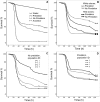Life history trade-offs and relaxed selection can decrease bacterial virulence in environmental reservoirs
- PMID: 22937098
- PMCID: PMC3427151
- DOI: 10.1371/journal.pone.0043801
Life history trade-offs and relaxed selection can decrease bacterial virulence in environmental reservoirs
Abstract
Pathogen virulence is usually thought to evolve in reciprocal selection with the host. While this might be true for obligate pathogens, the life histories of opportunistic pathogens typically alternate between within-host and outside-host environments during the infection-transmission cycle. As a result, opportunistic pathogens are likely to experience conflicting selection pressures across different environments, and this could affect their virulence through life-history trait correlations. We studied these correlations experimentally by exposing an opportunistic bacterial pathogen Serratia marcescens to its natural protist predator Tetrahymena thermophila for 13 weeks, after which we measured changes in bacterial traits related to both anti-predator defence and virulence. We found that anti-predator adaptation (producing predator-resistant biofilm) caused a correlative attenuation in virulence. Even though the direct mechanism was not found, reduction in virulence was most clearly connected to a predator-driven loss of a red bacterial pigment, prodigiosin. Moreover, life-history trait evolution was more divergent among replicate populations in the absence of predation, leading also to lowered virulence in some of the 'predator absent' selection lines. Together these findings suggest that the virulence of non-obligatory, opportunistic bacterial pathogens can decrease in environmental reservoirs through life history trade-offs, or random accumulation of mutations that impair virulence traits under relaxed selection.
Conflict of interest statement
Figures



Similar articles
-
Within-host evolution decreases virulence in an opportunistic bacterial pathogen.BMC Evol Biol. 2015 Aug 19;15:165. doi: 10.1186/s12862-015-0447-5. BMC Evol Biol. 2015. PMID: 26282271 Free PMC article.
-
Making a Pathogen? Evaluating the Impact of Protist Predation on the Evolution of Virulence in Serratia marcescens.Genome Biol Evol. 2024 Aug 5;16(8):evae149. doi: 10.1093/gbe/evae149. Genome Biol Evol. 2024. PMID: 38961701 Free PMC article.
-
Predation on multiple trophic levels shapes the evolution of pathogen virulence.PLoS One. 2009 Aug 25;4(8):e6761. doi: 10.1371/journal.pone.0006761. PLoS One. 2009. PMID: 19707586 Free PMC article.
-
Serratia marcescens.J Med Microbiol. 1997 Nov;46(11):903-12. doi: 10.1099/00222615-46-11-903. J Med Microbiol. 1997. PMID: 9368530 Review.
-
The genetic basis of local adaptation for pathogenic fungi in agricultural ecosystems.Mol Ecol. 2017 Apr;26(7):2027-2040. doi: 10.1111/mec.13870. Epub 2016 Oct 24. Mol Ecol. 2017. PMID: 27696587 Review.
Cited by
-
Within-host evolution decreases virulence in an opportunistic bacterial pathogen.BMC Evol Biol. 2015 Aug 19;15:165. doi: 10.1186/s12862-015-0447-5. BMC Evol Biol. 2015. PMID: 26282271 Free PMC article.
-
The adaptive evolution of virulence: a review of theoretical predictions and empirical tests.Parasitology. 2016 Jun;143(7):915-930. doi: 10.1017/S003118201500092X. Epub 2015 Aug 25. Parasitology. 2016. PMID: 26302775 Free PMC article. Review.
-
The evolution of reduced antagonism--A role for host-parasite coevolution.Evolution. 2015 Nov;69(11):2820-30. doi: 10.1111/evo.12785. Epub 2015 Oct 13. Evolution. 2015. PMID: 26420682 Free PMC article.
-
Growth rate, transmission mode and virulence in human pathogens.Philos Trans R Soc Lond B Biol Sci. 2017 May 5;372(1719):20160094. doi: 10.1098/rstb.2016.0094. Philos Trans R Soc Lond B Biol Sci. 2017. PMID: 28289261 Free PMC article.
-
Protist predation can select for bacteria with lowered susceptibility to infection by lytic phages.BMC Evol Biol. 2015 May 7;15:81. doi: 10.1186/s12862-015-0341-1. BMC Evol Biol. 2015. PMID: 25947228 Free PMC article.
References
-
- Van Valen L (1973) A new evolutionary law. Evolutionary Theory 1: 1–30.
-
- Frank SA (1996) Models of parasite virulence. Q Rev Biol 71: 37–78. - PubMed
-
- Marques JT, Carthew RW (2007) A call to arms: coevolution of animal viruses and host innate immune responses. Trends Genet 23 (7) 359–64. - PubMed
-
- Anderson RM, May RM (1982) Coevolution of hosts and parasites. Parasitology 85: 411–426. - PubMed
-
- Thompson JN, Burdon JJ (1992) Gene-for-gene coevolution between plants and parasites. Nature 360: 121–125.
Publication types
MeSH terms
LinkOut - more resources
Full Text Sources
Molecular Biology Databases
Research Materials

